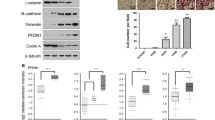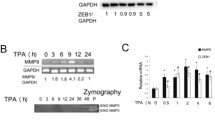Abstract
p21SNFT (21 kDa small nuclear factor isolated from T cells) is a human basic leucine zipper transcription factor that can repress AP-1-mediated transcription. We show here that overexpression of p21SNFT in HepG2 cells leads to repression of matrix metalloproteinase-1 by 70–80%. p21SNFT interacted with Jun at the matrix metalloproteinase-1 promoter −88 Ets/AP-1 enhancer element, where Jun is known to activate transcription via interaction with Fos and Ets proteins. When p21SNFT/Jun dimers bound the element in the presence of Ets, DNA was protected differently than when Fos was paired with Jun. The data suggest a difference in overall conformation between p21SNFT-containing and Fos-containing complexes that may be involved in the repression of matrix metalloproteinase-1 by p21SNFT. Overexpression of p21SNFT led to a reduction in invasiveness of HepG2 cells through type I collagen and reconstituted basement membrane, an effect similar to that obtained via direct immunodepletion of matrix metalloproteinase-1. The results indicate that the mechanism of repression of matrix metalloproteinase-1 by p21SNFT may be exploited in inhibiting pathological matrix remodeling during cancer progression in vivo.





Similar content being viewed by others
References
Angel P, Baumann I, Stein B, Delius H, Rahmsdorf HJ and Herrlich P . (1987). Mol. Cell. Biol., 7, 2256–2266.
Blanc JF, Bisson C, Frankenne F, Noel A, Munaut C, Colige A, Collette J, Rosenbaum J and Foidart JM . (2002). Int. J. Oncol., 20, 1129–1136.
Borden P and Heller RA . (1997). Crit. Rev. Eukaryot. Gene Expr., 7, 159–178.
Bower KE, Zeller RW, Wachsman W, Martinez T and McGuire KL . (2002). J. Biol. Chem., 277, 34967–34977.
Buttice G, Duterque-Coquillaud M, Basuyaux JP, Carrere S, Kurkinen M and Stehelin D . (1996). Oncogene, 13, 2297–2306.
Chapman SC, Ayala JE, Streeper RS, Culbert AA, Eaton EM, Svitek CA, Goldman JK, Tavare JM and O’Brien RM . (1999). J. Biol. Chem., 274, 18625–18634.
Curran S and Murray GI . (1999). J. Pathol., 189, 300–308.
Curtiss VE, Smilde R and McGuire KL . (1996). Mol. Cell. Biol., 16, 3567–3575.
Fried MG . (1989). Electrophoresis, 10, 366–376.
Gutman A and Wasylyk B . (1990). EMBO J., 9, 2241–2246.
Iacobelli M, Wachsman W and McGuire K . (2000). J. Immunol., 165, 860–868.
Inoue T, Yashiro M, Nishimura S, Maeda K, Sawada T, Ogawa Y, Sowa M and Chung KH . (1999). Int. J. Mol. Med., 4, 73–77.
Ito T, Ito M, Shiozawa J, Naito S, Kanematsu T and Sekine I . (1999). Mod. Pathol., 12, 669–674.
Jonat C, Stein B, Ponta H, Herrlich P and Rahmsdorf HJ . (1992). Matrix Supp., 1, 145–155.
Kim JH, Kim TH, Jang JW, Jang YJ, Lee KH and Lee ST . (2001). Mol. Cells, 12, 32–40.
Matrisian LM . (1990). Trends Genet., 6, 121–125.
McGuire KL and Iacobelli M . (1997). J. Immunol., 159, 1319–1327.
Mengshol JA, Mix KS and Brinckerhoff CE . (2002). Arthritis Rheum., 46, 13–20.
Murray GI, Duncan ME, O’Neil P, McKay JA, Melvin WT and Fothergill JE . (1998). J. Pathol., 185, 256–261.
Murray GI, Duncan ME, O’Neil P, Melvin WT and Fothergill JE . (1996). Nat. Med., 2, 461–462.
Nagese H and Woessner Jr JF . (1999). J. Biol. Chem., 274, 21491–21494.
Nikolajczyk BS, Nelson B and Sen R . (1996). Mol. Cell. Biol., 16, 4544–4554.
Ozaki I, Zhao G, Mizuta T, Ogawa Y, Hara T, Kajihara S, Hisatomi A, Sakai T and Yamamoto K . (2002). J. Hepatol., 36, 169–178.
Siller-Lopez F, Garcia-Banuelos J, Hasty KA, Segura J, Ramos-Marquez M, Qoronfleh MW, Aguilar-Cordova E and Armendariz-Borunda J . (2000). J. Hepatol., 33, 758–763.
Sunami E, Tsuno N, Osada T, Saito S, Kitayama J, Tomozawa S, Tsuruo T, Shibata Y, Muto T and Nagawa H . (2000). Oncologist, 5, 108–114.
Tini M, Jewell UR, Camenisch G, Chilov D and Gassmann M . (2002). Comp. Biochem. Physiol. A, 131, 569–574.
Weinmann AS, Bartley SM, Zhang T, Zhang MQ and Farnham PJ . (2001). Mol. Cell. Biol., 21, 6820–6832.
Westermarck J, Steh A and Kahari V-M . (1997). Oncogene, 14, 2651–2660.
Westermark J and Kahari VM . (1999). FASEB J., 13, 781–792.
Acknowledgements
We thank Sara McBride and Tong Xu for isolation of chicken anti-p21SNFT #12 antiserum, Alicia Arroyo for technical assistance in Type I Collagen invasion assays, and Robert W Zeller and Michael Breindl for critical review of the manuscript. The pUC9pCllase II construct was kindly provided by Peter Angel, the his-Ets-1 DBD plasmid by Barbara Nikolajczyk, the Ets/AP-1CAT constructs by Richard O’Brien, and MMP-2 primers and chicken embryo fibroblast total RNA by Andreas Bader. This work was supported by AHA Predoctoral Fellowship #0215001Y and a Sigma Xi Grant-In-Aid (to KEB) and Cancer Research Program Grant 99-00542V-10051 (to KLM).
Author information
Authors and Affiliations
Corresponding author
Rights and permissions
About this article
Cite this article
Bower, K., Fritz, J. & McGuire, K. Transcriptional repression of MMP-1 by p21SNFT and reduced in vitro invasiveness of hepatocarcinoma cells. Oncogene 23, 8805–8814 (2004). https://doi.org/10.1038/sj.onc.1208109
Received:
Revised:
Accepted:
Published:
Issue Date:
DOI: https://doi.org/10.1038/sj.onc.1208109
- Springer Nature Limited
Keywords
This article is cited by
-
Prediction of enhancer–promoter interactions using the cross-cell type information and domain adversarial neural network
BMC Bioinformatics (2020)
-
Batf3
AfCS-Nature Molecule Pages (2009)




